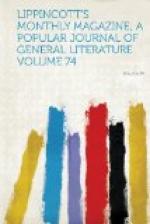Of course, in a country containing a population of over one hundred and fifty-one millions, one thousand public schools for girls, supplemented as these are by missionary schools of many denominations, are inadequate to meet the needs of the people. There is an increasing demand in all the provinces for schools and colleges; and the native young men especially are eagerly seeking the educational advantages of the colleges and universities, because they know that these are a sure road to preferment. “The government takes care to give employment to those who wish it.”
The difficulties in the way of female education in India are well expressed in a late letter from one of the most distinguished native reformers, Baboo Keshub Chunder Sen of Calcutta. “No words of mine,” he says, “would convey to you an adequate idea of the great obstacles which the social and religious condition of the Hindoo community presents in the way of female education and advancement. In a country where superstition and caste prejudices prevail to an alarming extent, where widows are cruelly persecuted and prevented from remarrying, where high-caste Hindoos are allowed to marry as many wives as they like without undertaking the responsibility of protecting them, and where little girls marry at a most tender age and sacrifice all prospects of healthy physical and mental development, it will take centuries before any solid and extensive reform is achieved.”
Until recently, scarcely one woman in ten thousand learned to read or acquired any of the accomplishments common to women of Christian countries. Occasionally, women of vicious lives in cities, having leisure, became quite learned, and this made learning a shame for women of irreproachable reputation. Moreover, Hindoo husbands declared, and believed, that if you taught a woman to read she would be sure in time to have illicit relations with some one. Ignorance was innocence, the safeguard of both rank and chastity.
The missionaries, who were the first to attempt the amelioration of the people, had to commence with the lowest castes or classes, those having nothing to lose; and even then the teachers had to pay the girls a small copper coin daily for attending school. Even the government schools in some places pay the girls for attending, but they are much more popular than the missionary schools, because, according to the Rev. Joseph Warren in the report mentioned, the parents are not afraid that their girls will become Christians by attending them; and he adds that the government teachers and books are “all positively heathen or quite destitute of all religion.” In some parts of the country the government schools secure the attendance of high-caste girls by allowing them to be placed behind a curtain, and thus screened from the eyes of the male teacher or inspector, as all the women of such classes are screened from male visitors. Even the physician sees only a hand protruded from under a curtain, and by the touch of this, with a few unsatisfactory answers to his questions, he is supposed to be able to know what the malady is, and how to prescribe for it.




